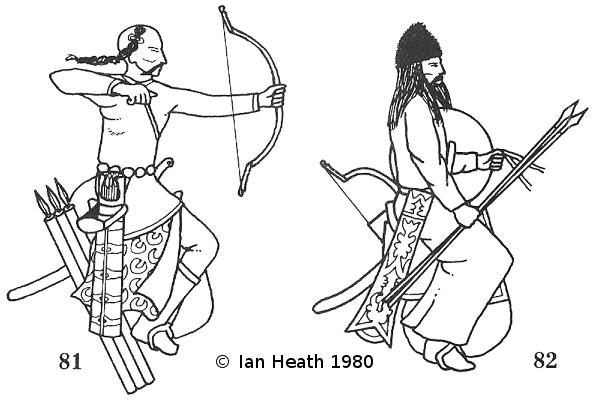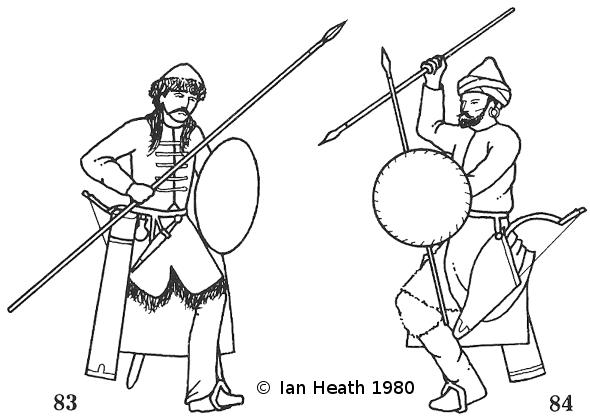 |
Find the perfect fit with Amazon Prime. Try Before You Buy. Find the perfect fit with Amazon Prime. Try Before You Buy. |
81, 82, 83 & 84. ASIATIC LIGHT CAVALRYMEN
An extract from Armies of the Dark Ages 600-1066by Ian Heath
 |
Find the perfect fit with Amazon Prime. Try Before You Buy. Find the perfect fit with Amazon Prime. Try Before You Buy. |
81, 82, 83 & 84. ASIATIC LIGHT CAVALRYMEN
For this period information on the Central Asian nomad hordes has to be gleaned from those contemporary ‘outsiders’ — Germans, Scandinavians, Russians, Byzantines, Armenians, Arabs and Chinese — with whom they came into contact. Fortunately styles of costume and armour were almost universal across the steppes and changed little through the centuries.
Therefore although 81 is an Avar his general appearance is characteristic of nearly all the steppe peoples. His dirty black hair is shaved high on the scalp, with one long lock plaited with coloured ribbons and held by gold clasps. One source claims that their long hair earnt the Avars their name — probably in much the same way that it has been suggested, albeit inaccurately, that the name Khazar may have derived from Russian ‘kosa’, meaning pigtail. 2 tresses, one at each ear, were sometimes worn in addition (see 73a). The shaved head was especially characteristic of most of the Turkish peoples of Central Asia, amongst whom it was also customary to shave off the beard (what little most of them could grow). The Magyars at least often had scarred faces like the earlier Huns, as did some Slavs.
Basic costume consisted of a long, loose under-tunic split at front and back, a kaftan, a short over-tunic, trousers, boots and occasionally a cloak. Clothing materials included silk brocade, dyed leather (scarlet, red and purple leather often being supplied by the Byzantines as payment to mercenaries), furs (sable, ermine, fox, stoat, grey squirrel, wolf, bear, and sometimes more exotic furs such as leopard and monkey) and wool. Boots were felt and/or leather, with soft soles so that when squeezed through the stirrup the foot could maintain a tight grip.
82 is from a late-9th century Byzantine ms. His costume appears to be somewhat different, but the apparent baggy shirt and wide, flowing trousers are probably no more than a long Arab-style topcoat split for riding. His long hair is unusual and marks him as a Pecheneg or Patzinak, who in addition sported impressive beards and moustaches. Their clothes were of gabardine, except for nobles who wore silk. Pointed fur or felt caps were characteristic of the Pechenegs and usually black.
Several sources also record the Khazars as having long flowing hair; this is described as both reddish and black. One part of the Khazar nation is said to have been as dark-skinned as Indians.
81 and 82 are each armed with sabre (a curved, one-edged cutting sword which generally replaced the straight sword c. 700) and a composite bow of which 2 or sometimes 3 were often carried. Quivers apparently contained up to 60 arrows but more commonly held 24-30, usually carried point uppermost. These arrows were light, which somewhat limited their penetration. Both carry in addition light, hollow javelins, 81 having them in a case suspended from the saddle. Lassoes were also carried to entangle enemy riders and horses in close combat. Magyars and Pechenegs at least are recorded to have sometimes carried axes, and most Asiatics probably also carried small circular shields of leather or interwoven osiers.
83 is a Danube Bulgar of c. 1017from the Menologium of Basil II. Another Byzantine source records that the Bulgars had adopted Avar dress, While Liudprand of Cremona records a 10th century Bulgar nobleman with a bronze chain belt and Magyar-style haircut (like 81). However, the appearance of this figure would indicate that many of these practices had died out by the 11th century. Note also that he carries a sword rather than a sabre.
84 is a Burta, the most important of a number of similar Finnish tribes. His headwear is a Persian kulah with a turban wrapped round it. He is armed with bow and 2 javelins and carries a hide shield but, despite the fact that only their upper-classes fought on horseback, he owns no body armour. Note the ear-ring; only one would be worn, as is still the case among many modern Central Asian nomads. Clothing consisted largely of reindeer and stoat, worn hairy side out, though Marvazi records the Yuras, another Finnish tribe, wearing sable and other furs. Since the reindeer jerkins mentioned under 68 were of finnish origin it would seem that some of their outer coats at least served as a form of armour. The Baskirs were practically identical and Volga Bulgars were also similar, though they shaved their heads and wore boots and were apparently virtually indistinguishable from Arabs in their basic dress, wearing trousers, long topcoats and turbans.
Some Turks continued to tattoo themselves Scythian-fashion until at least the 10th century, Psellus recording ‘Scyths’ (probably Pechenegs) ‘painting’ themselves even in the mid-11th century.
